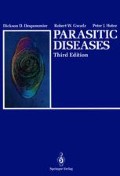Abstract
Enterobius vermicularis, coomonly known as pinworm, in the etiologic agent of the the most pervalent nematode infection of humans in temperate climates, affecting mainly children less than 12 years of age. Transmission of enterobiasis is especially frequent in elementary shools and day-care centers. 1 It has no host other than humans.
Access this chapter
Tax calculation will be finalised at checkout
Purchases are for personal use only
Preview
Unable to display preview. Download preview PDF.
References
Crawford FG, Vermund SH: Parasitic infections in day care centers. Pediatr Infect Dis J 6: 744–749, 1987
Bremser JG: Oxyure vermiculaire. In: Traite zoologique et physiologique sur les vers intestinaux de l’homme. CL.F. Panchouke, Paris, 1824, pp 149–157
Pearson RD, Irons Sr RP, Irons Jr RP: Chronic pelvic peritonitis due to the pinworm Enterobius vermicularis. JAMA 245: 1340–1341, 1981
Beckman EN, Holland JB: Ovarian enterobiasis—a proposed pathogenesis. Am J Trop Med Hyg 30: 74–76, 1981
Daly JJ, Baker GF: Pinworm granuloma of the liver. Am J Trop Med Hyg 33: 62–64, 1984
Jacobson RH, Reed ND: The thymus dependency of resistance to pinworm infection in mice. J Parasitol 60: 976–979, 1974
Mattia AR: Perianal mass and recurrent cellulitis due to Enterobius vermicularis. Am J Trop Med Hyg 47: 811–815, 1992
Weiler TH, Sorenson CW: Enterobiasis: its incidence and symptomatology in a group of 505 children. N Engl J Med 224: 143–146, 1941
Blumenthal DS, Schultz MG: Incidence of intestinal obstruction in children infected with Ascaris lumbricoides. Am J Trop Med Hyg 24: 801–805, 1975
Maqbool S, Lawrence D, Katz M: Treatment of trichuriasis with a new drug, mebendazole. J Pediatr 86: 463–465, 1975
Aubry ML, Cowell P, Davey MJ, et al: Aspects of the pharmacology of a new anthelminthic, pyrantel. Br J Pharmacol 38: 332–344, 1970
Author information
Authors and Affiliations
Rights and permissions
Copyright information
© 1995 Springer-Verlag New York, Inc.
About this chapter
Cite this chapter
Despommier, D.D., Gwadz, R.W., Hotez, P.J. (1995). Enterobius vermicularis (Linnaeus 1758). In: Parasitic Diseases. Springer, New York, NY. https://doi.org/10.1007/978-1-4612-2476-1_1
Download citation
DOI: https://doi.org/10.1007/978-1-4612-2476-1_1
Publisher Name: Springer, New York, NY
Print ISBN: 978-1-4612-7554-1
Online ISBN: 978-1-4612-2476-1
eBook Packages: Springer Book Archive

